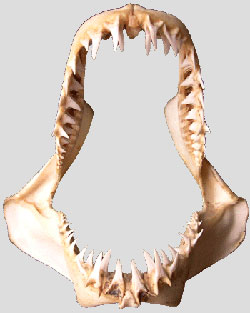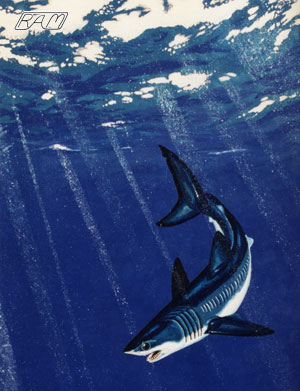Open Ocean: the Blue Desert
Shortfin Mako
Beautifully streamlined, the Shortfin Mako (Isurus oxyrinchus) is the champion speedster among sharks. This species has been reliably clocked at 31 miles (50 kilometres) per hour and there are claims that it can achieve burst swimming speeds of at least 46 miles (74 kilometres) per hour. Shortfin Makos are also astonishingly hyperkinetic, known to leap repeatedly some 20 feet (6 metres) out of the water, a talent that makes them much sought-after as a premier game fish.
Just the Facts:
Size:
Reproduction:
Diet:
Habitat: Rocky Reefs, Kelp Forests, Coral Reefs, Open Ocean Depth: surface to at least 1300 ft (400 m) Distribution: Arctic, Antarctic, North Pacific, Central Pacific, South Pacific, Temperate Eastern Pacific, Tropical Eastern Pacific, Chilean, North Atlantic, South Atlantic, Western North Atlantic, Caribbean, Amazonian, Argentinean, Eastern North Atlantic/Mediterranean, West African, Southern African, Central South Indian, Madagascaran, Arabian, Indian, South East Asian, Western Australian, Southeast Australian/New Zealand, Northern Australian, Japanese |
Everything about the Shortfin Mako is modified for an active, high-speed lifestyle. Its snout is acutely pointed, its body is slender and spindle-shaped with a narrow tail stalk featuring an efficient tuna-like caudal fin supported by lateral keels. The Mako’s gills are large, extending most of the body’s depth, and bear long gill filaments for efficient uptake of oxygen. Its heart is huge and thickly muscled to pump red blood cell-rich blood to the powerfully interdigitating propulsive muscles. And, like its close relative the White Shark (Carcharodon carcharias), the Shortfin Mako possesses a circulatory system modified to retain metabolic heat, maintaining body temperatures 12.5 to 18 degrees Fahrenheit (7 to 10 degrees Celsius) warmer than the ambient water. This endowment grants it increased speed and the ability to pursue prey into cool or deep water. All these features add up to a spare, efficient swimming machine of extraordinary speed, power and endurance.
Add to these swimming capabilities a large mouth armed with impressive teeth, and you have a recipe for a top-level predator able to catch and eat the fastest creatures in the sea. The anterior teeth of the Shortfin Mako are slender, smooth-edged, and recurved, ideal for grasping slippery bodied prey small enough to be swallowed whole. Smaller fish removed from Makos’ stomachs typically bear nasty, stab-like punctures around the mid-body, while larger fishes are usually found inside with their tails neatly bitten off. Such forensic evidence suggests that Shortfin Makos catch their prey ‘on-the-fin’.

Jaws of a Shortfin Mako, showing grasping dentition
Shortfin Makos seem to have a particular dietary predilection for a commercially important jack known as the Bluefish (Pomatomus saltator). One study in the western North Atlantic found that, by volume, 78% of Shortfin Mako prey consisted of Bluefish. Based on estimates that the stomach capacity of a Shortfin Mako averages about 10% of its body weight and a daily ration is about 4.5 pounds (2 kilograms), researchers calculate that Shortfin Makos may consume as much as 15% of the available Bluefish resource in the area between Georges Bank and Cape Hatteras.
Like those of its close relative, the White Shark, the upper anterior teeth of the Shortfin Mako broaden and flatten significantly in individuals over 10 feet (3 metres) in length. This change in tooth shape enables large Makos to prey efficiently upon dolphins, other sharks — including Blue Sharks (Prionace glauca) — tunas, and even the large, pugnacious and heavily-armed Broadbill Swordfish (Xiphias gladius).
The Shortfin Mako is one of the few known predators of the Swordfish. A 730-pound (330-kilogram) Shortfin Mako harpooned near Bimini, Bahamas, was found to contain a whole 120-pound (55-kilogram) Swordfish. Off Montauk, New York, another Shortfin Mako of about 800 pounds (365 kilograms) was observed biting the tail off a Swordfish of undetermined size. When this shark was landed, it was found to contain about 150 pounds (68 kilograms) of Swordfish flesh.
To seek out sufficient prey or suitable mates, the Shortfin Mako covers large areas of open ocean. In December 1998, a female specimen originally tagged off California was recaptured by a Japanese research vessel in the central Pacific, having traveled over 1,725 miles (2,780 kilometres). This was only the second time a Shortfin Mako was recaptured from this region. Tagging studies conducted off the east coast of New Zealand reveal that Shortfin Mako recaptures at or very close to original tagging sites peak annually, indicating seasonal migrations. Where these sharks go for the rest of the year is unclear, although one individual tagged off New Zealand was recaptured north-west of Fiji.
 Shortfin Makos tagged in the western North Atlantic are rarely reported
from off Europe. In 28 years of National Marine Fisheries Service tagging
off the U.S. East Coast, only a single tag — from a specimen recaptured off
the coast of Spain, a straight-line distance of some 2,280 miles (4,540
kilometres) — has been recovered from the eastern North Atlantic. This fact
suggests a very limited population exchange between the eastern and western
North Atlantic, an hypothesis supported by genetic sampling from both sides
of this ocean basin.
Shortfin Makos tagged in the western North Atlantic are rarely reported
from off Europe. In 28 years of National Marine Fisheries Service tagging
off the U.S. East Coast, only a single tag — from a specimen recaptured off
the coast of Spain, a straight-line distance of some 2,280 miles (4,540
kilometres) — has been recovered from the eastern North Atlantic. This fact
suggests a very limited population exchange between the eastern and western
North Atlantic, an hypothesis supported by genetic sampling from both sides
of this ocean basin.
General daily and seasonal activity patterns of the Shortfin Mako are not well known. At the extreme northern and southern parts of its range, this species tends to follow movements of warm water. Tagging studies conducted off the northeastern United States show a seasonal pattern of Shortfin Mako abundance along the western margin of the Gulf Stream. These sharks apparently move inshore and into higher latitude waters as the Stream shifts northward from April through October and possibly winter in the Sargasso Sea from November through March.
Shortfin Makos are common in coastal and oceanic regions of tropical and warm temperate seas, but seldom occur in waters less than 61 degrees Fahrenheit (16 degrees Celsius). Young individuals tracked in the Southern California Bight spent 90% of their time in the 68 to 70 degree Fahrenheit (20 to 21 degree Celsius) mixed-water layer just above the thermocline, which occurred at a depth of 45 to 65 feet (14 to 20 metres). In contrast, a large adult female tracked travelling from Cape Canaveral, Florida, to the Bahamas spent most of her time well below the mixed layer, reaching depths greater than 1,300 feet (400 metres) on several occasions.
Maintaining a warm body in cold water requires burning a lot of caloric energy. It is therefore possible that young Shortfin Makos do not have the bodily resources to make prolonged forays into colder or deeper water. Alternatively, since the metabolic processes associated with somatic growth proceed more rapidly at higher temperatures (within limits of protein stability), perhaps remaining in warmer waters above the thermocline is a strategy for enhancing growth. In this way, new-born Shortfin Makos might more quickly reach a size to discourage all but the most formidable of predators and enjoy the benefits of more efficient swimming associated with greater body size. Time and further research may tell.
Shortfin Mako
Bibliography
More about: Shortfin Mako
| Speed of Marine Animals |
Power of Shark Bites

